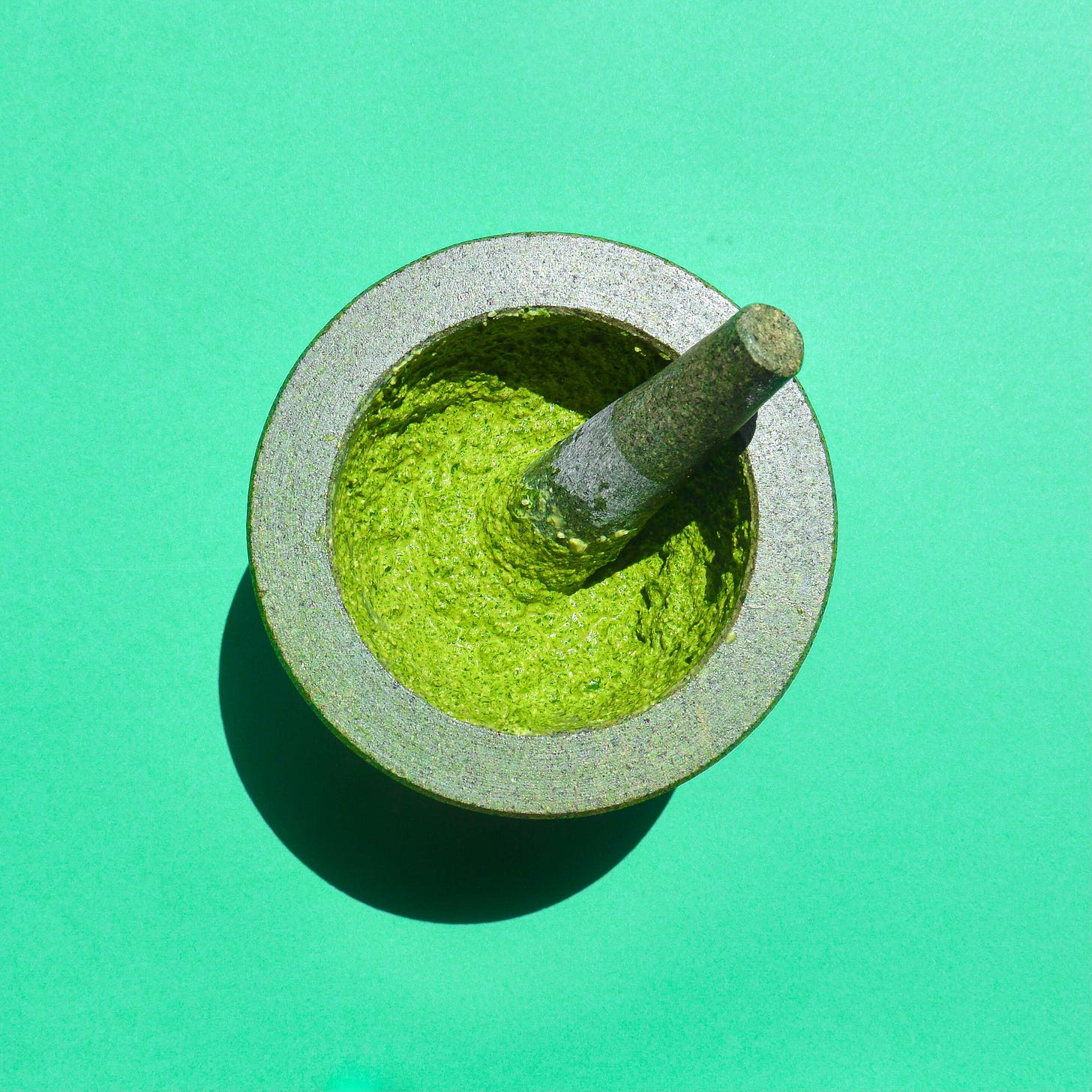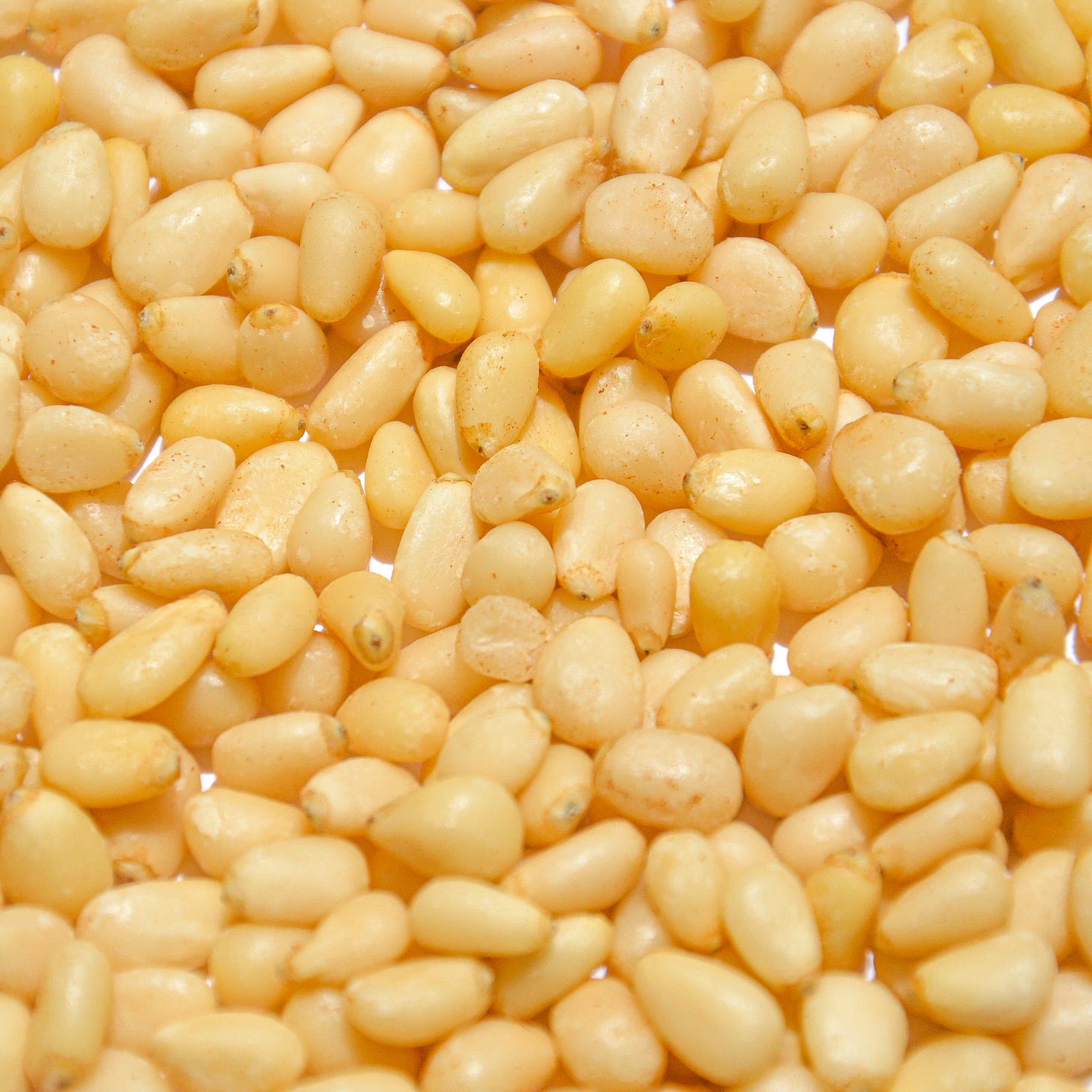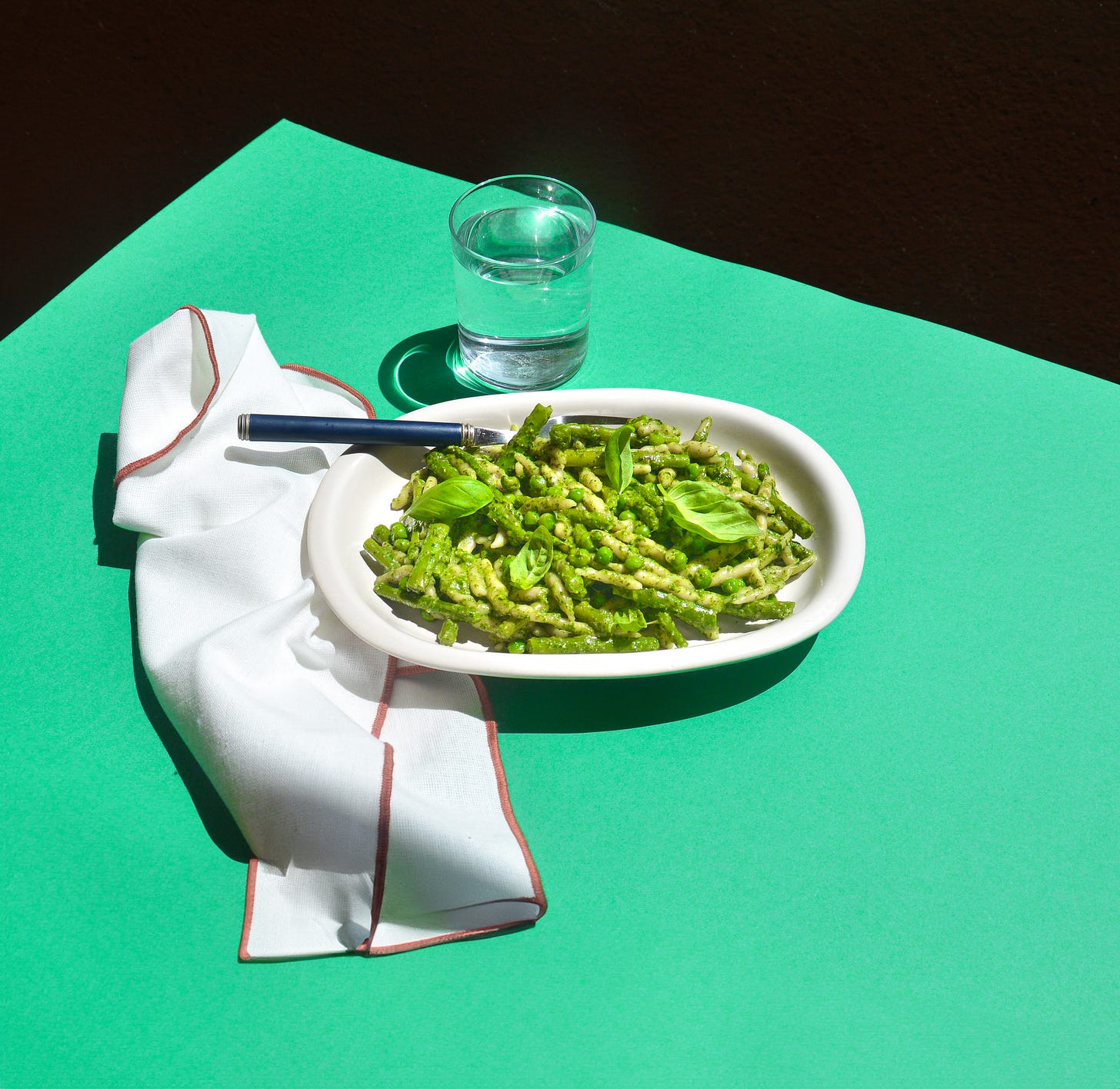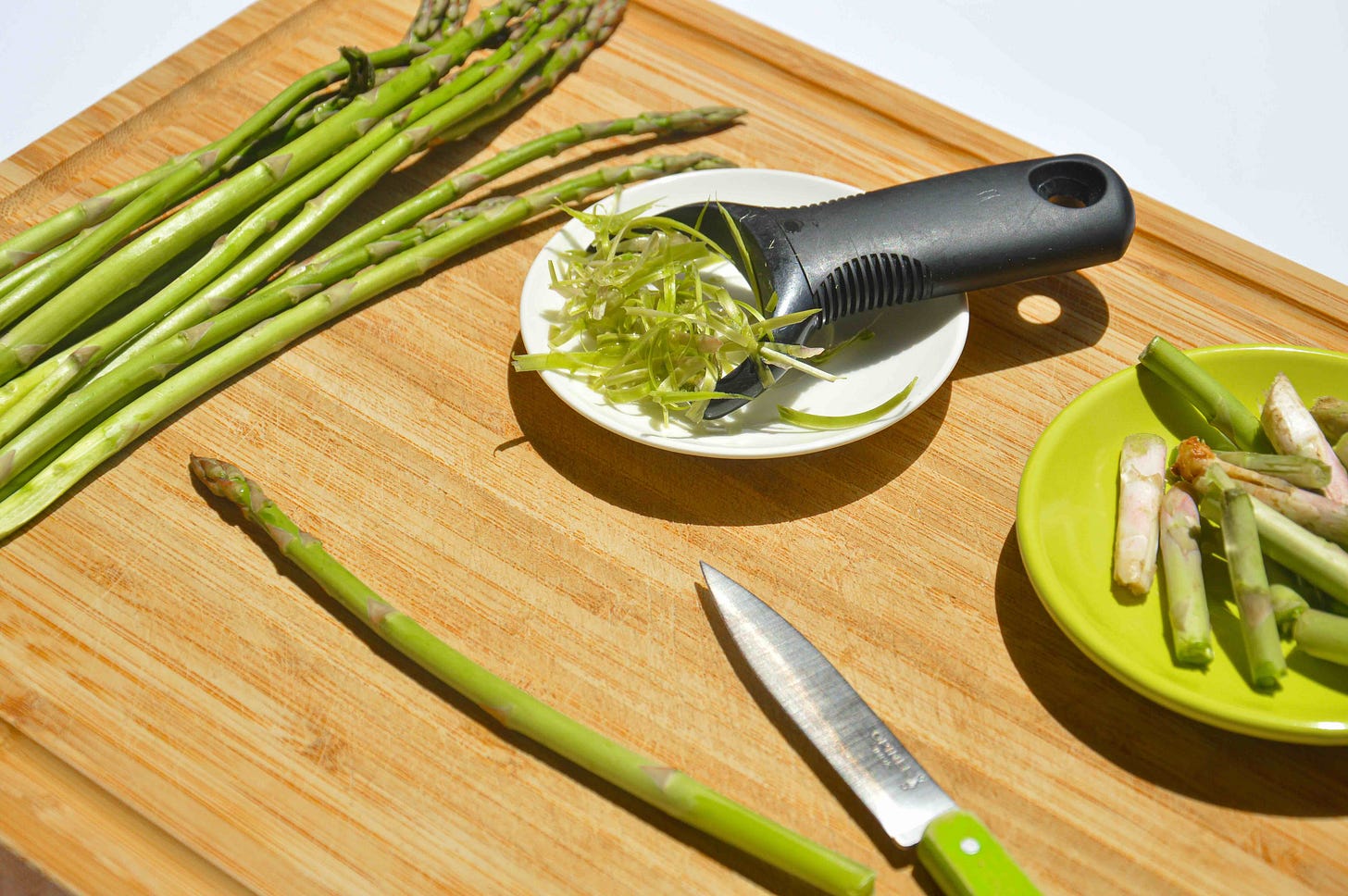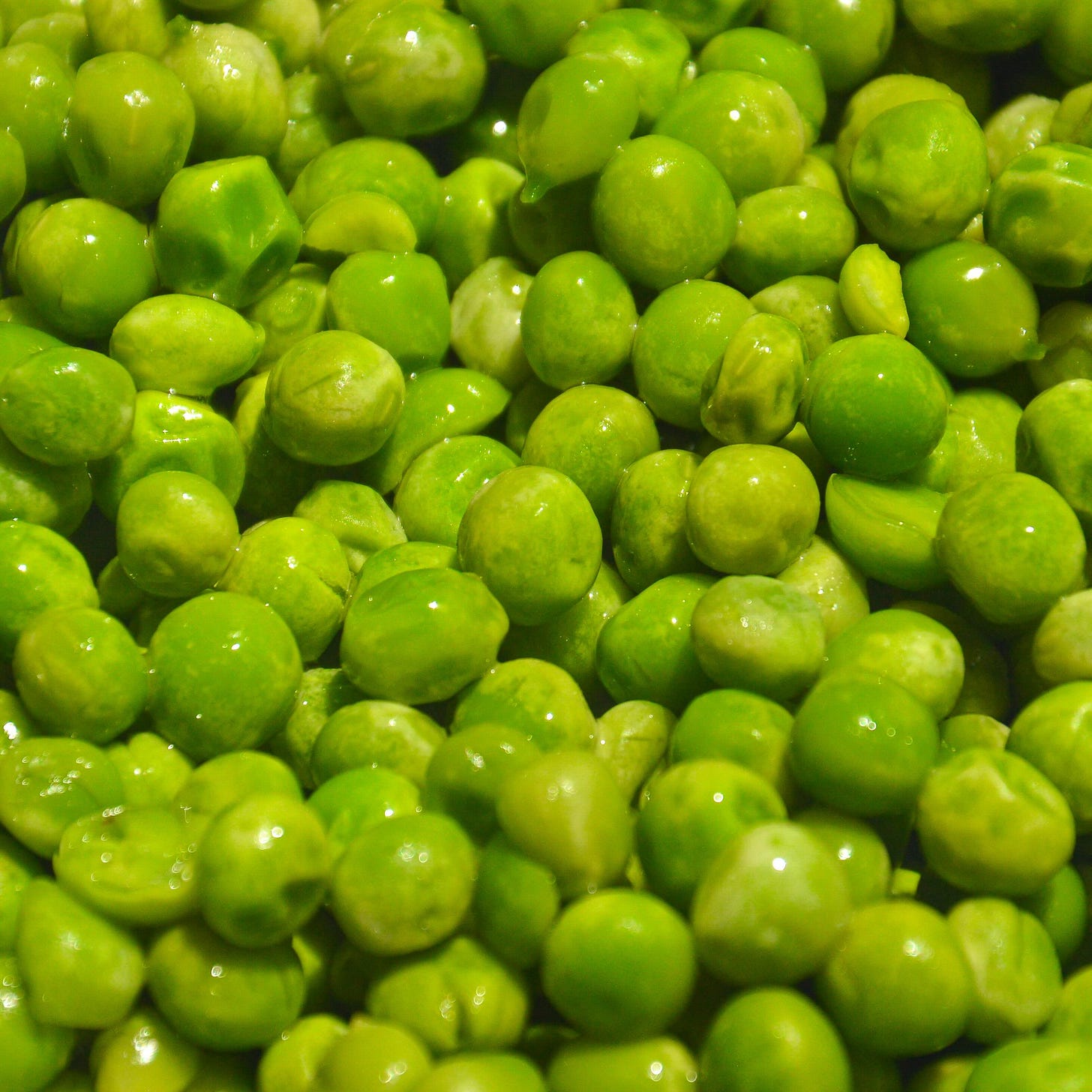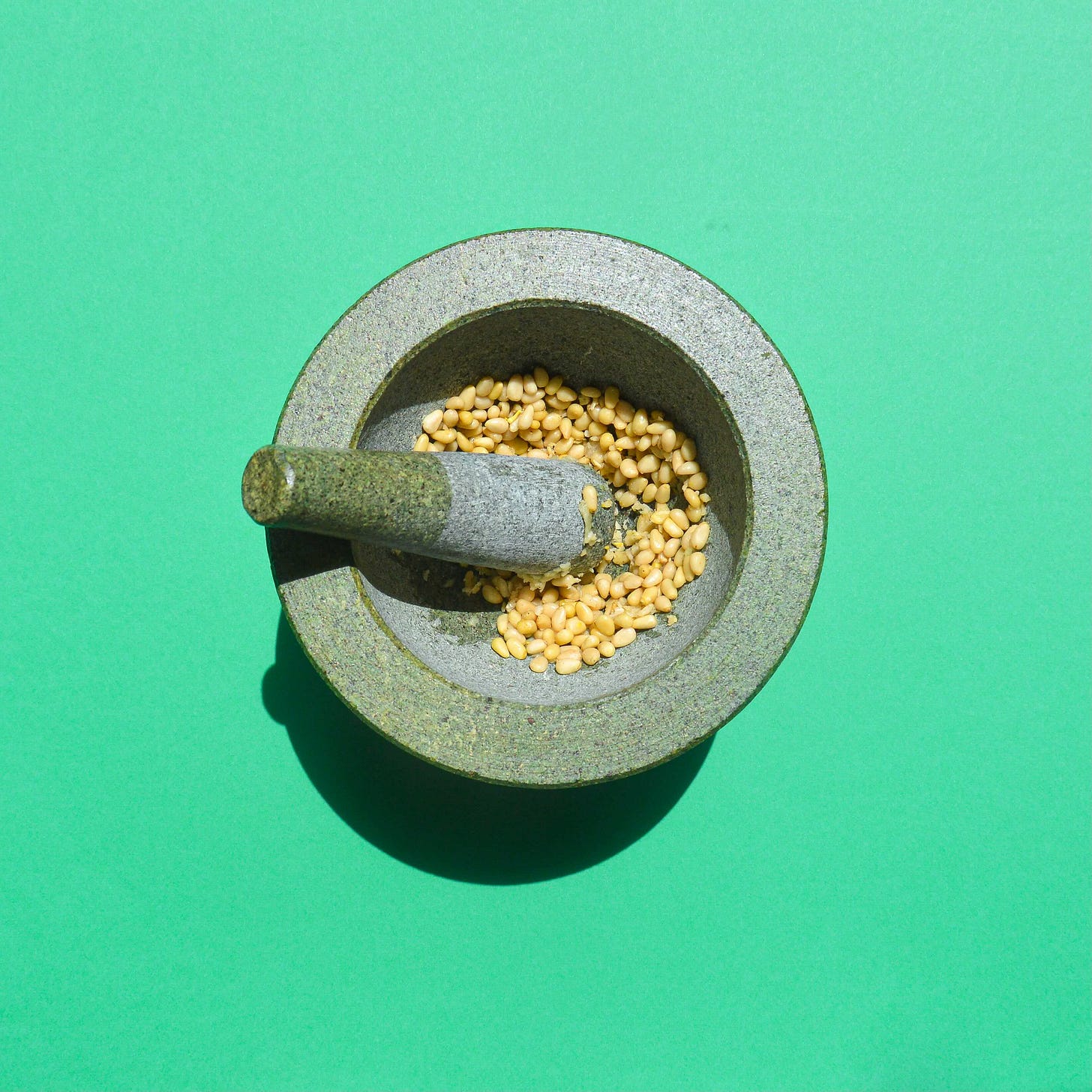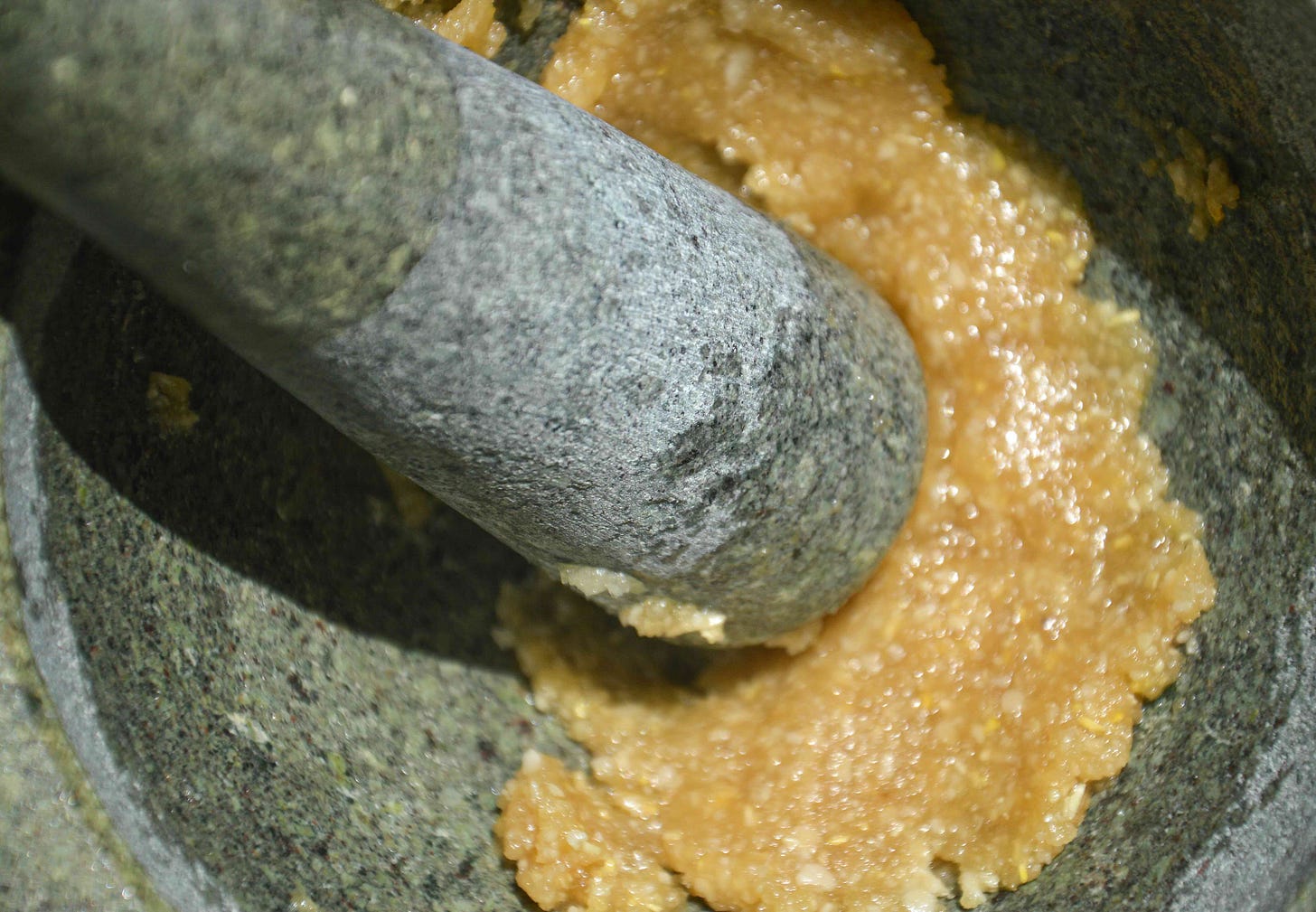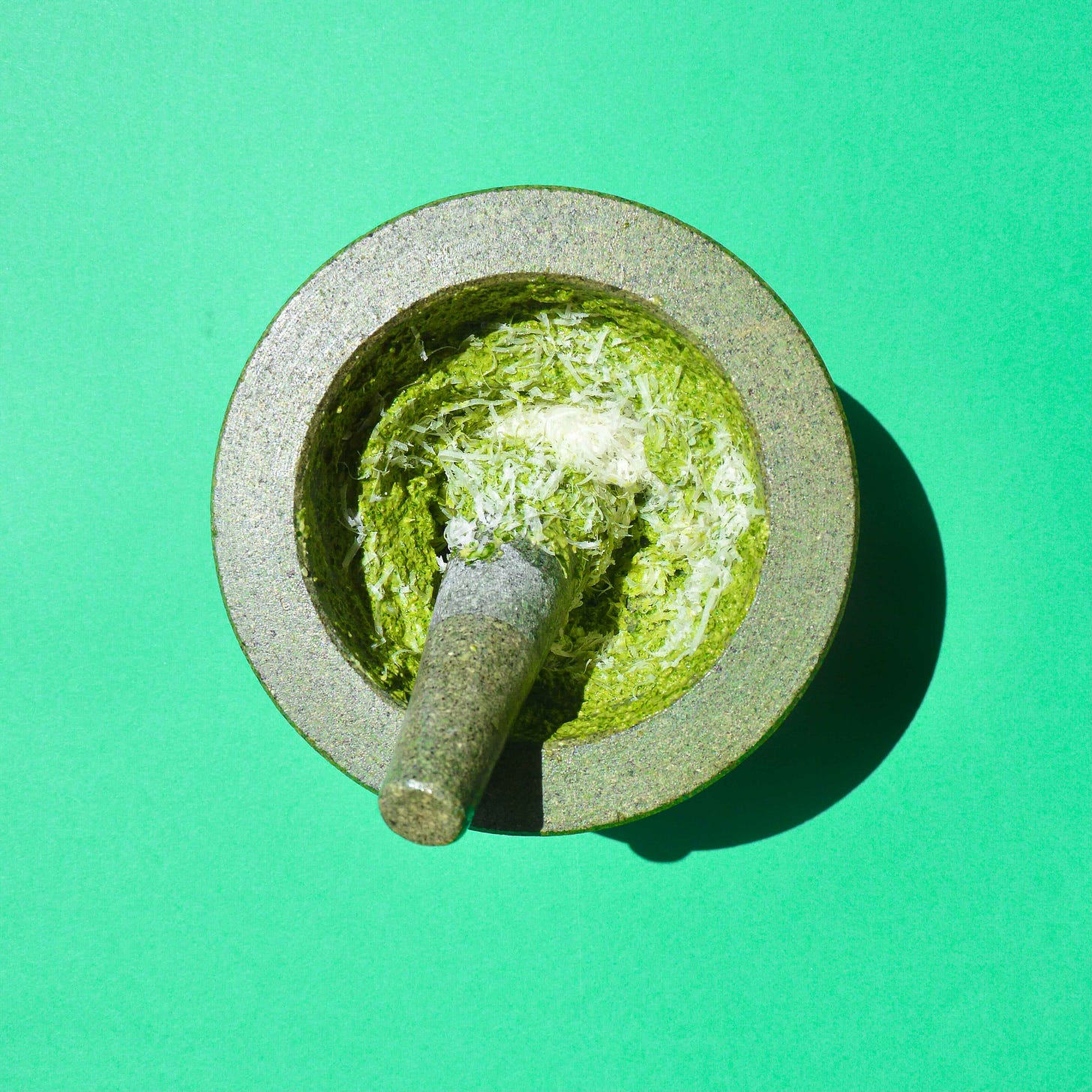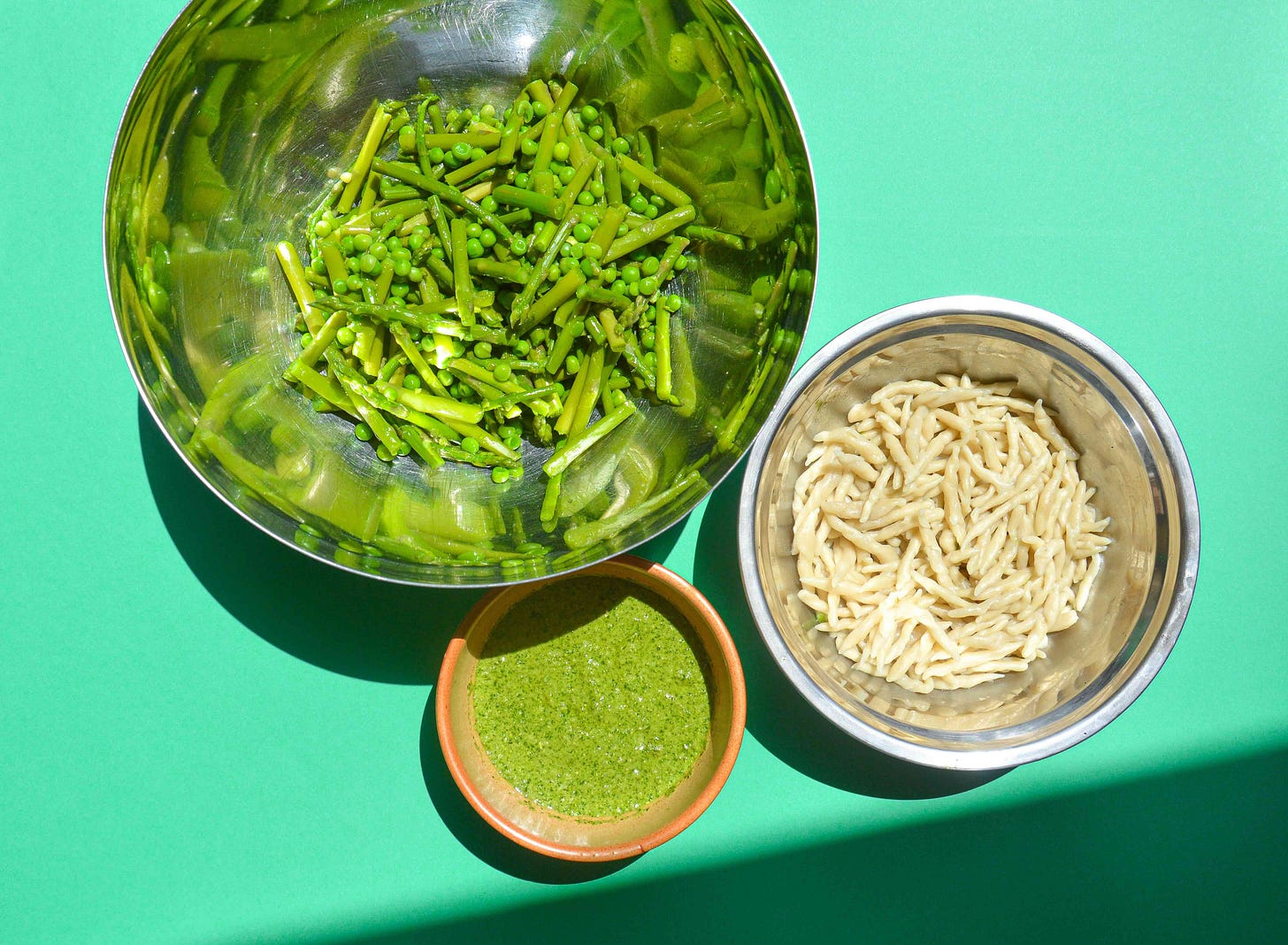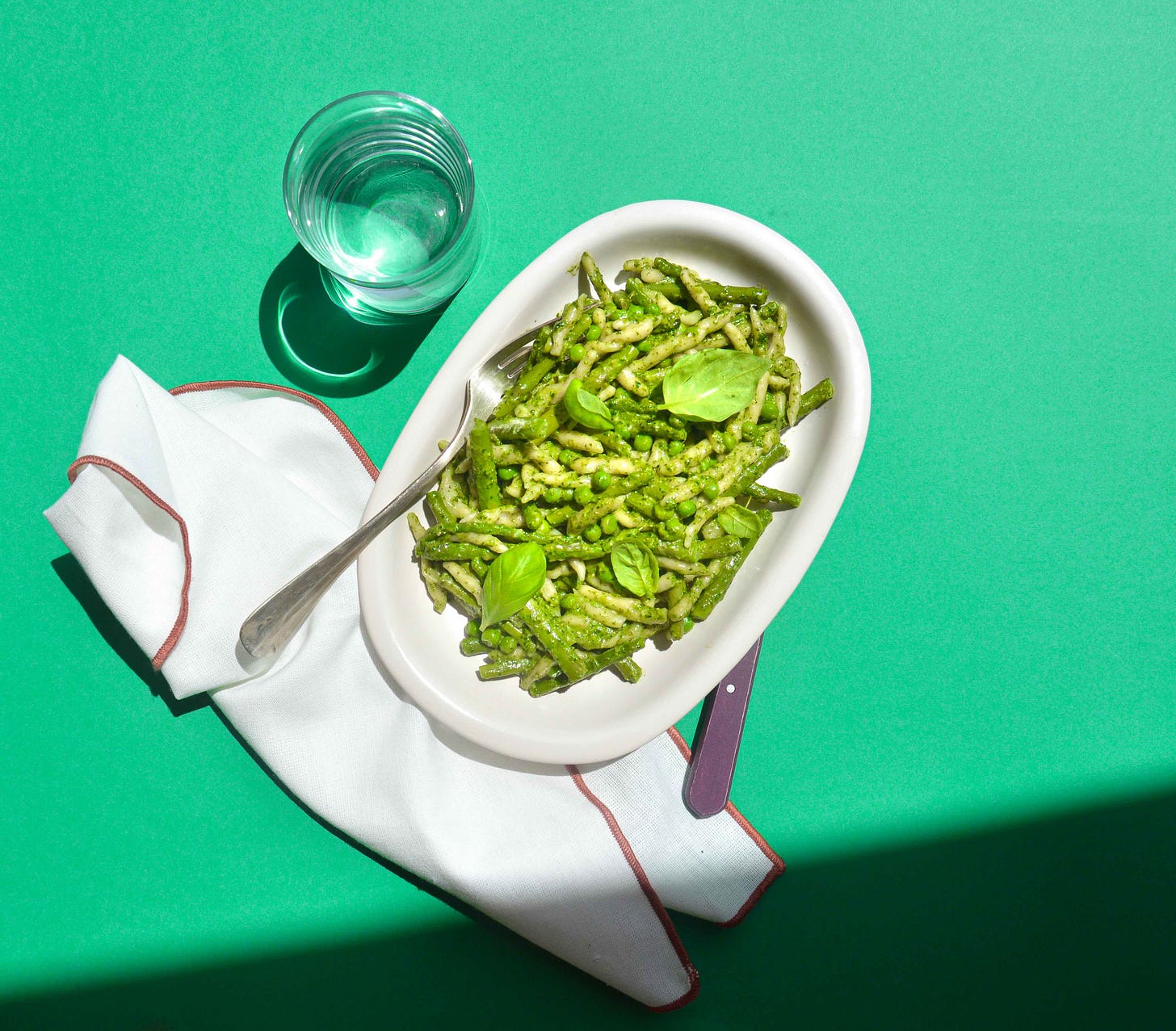Facts about pesto:
As the name suggests, pesto alla Genovese originated in the Italian northwest city of Genoa in Liguria
The name pesto comes from the Italian word ‘pestare’ which means to pound
There are many pesto varieties in Italy, such as tomato-based Trepanese made with tomatoes and almonds or the classic basil-based Genovese
Traditionally, the ingredients are pounded together in a mortar using a pestle
According to Garum Museo della Cucina in Rome, the first written documentation of the Pesto alla Genovese recipe was featured in a cookbook La Cuciniera Genovese written by Giovanni Battista Ratto and published in 1863
Every two years, the pesto tournament - World Pesto Championship is held in Genoa. Notably, in 2008 Danny Bowien, the chef and owner of Mission Chinese Food won the top prize!

Pesto alla Genovese with hand-made trofie and spring vegetables
Serve: 4
Ingredients:
Dough
300g of 00 (finely ground) wheat flour
170g warm water
Pesto
4g garlic (about 1 clove)
30g pine nuts
100g fresh basil + some for serving
15g Parmigiano Reggiano + some for serving
5g Pecorino Sardo
70g extra virgin olive oil
3g sea salt
Vegetables
300g green asparagus
150g peas
Extra note:
Make the pasta in advance to allow sufficient time for it to dry properly
While purchasing extra virgin olive oil - opt for the milder options
Pine nuts are traditionally used in pesto alla Genovese, but if you can’t get them, walnuts are a great substitution
You can use Pecorino Romano instead of the Pecorino Sardo. However, be mindful that the former is much saltier and more intense
Method
Dough for the pasta
Place 00 flour on the counter and make a well in the middle. Gradually start adding water to the centre while stirring the flour into the liquid using a fork. Don’t add all the water at once and start with about half of it. If it’s too dry - add more liquid. Remember that the amount of liquid depends on the humidity of the environment and the flour, so you might need to adjust the amount a little.
Form a shaggy ball with your hands, then knead the dough. Press the heel of your palm in the middle of the dough and start stretching it away from your body. Fold the dough, press down and rotate it. Repeat the process. In the beginning, the dough might be quite dry and hard to knead, but give it a bit more time and it will improve.
Knead the dough for 10 minutes or until it looks smooth. Cover it with a clingfilm to prevent drying and let it relax for around 30 minutes.
Shaping the pasta
Work on a wooden chopping board as it has a better grip than a counter.
Make about 10 red bean-size dough pieces (by taking away bits from the main dough) and cover the rest of the dough with a clingfilm.
Roll a small piece with your index and your middle fingers into a rope making sure the sides are slightly thinner than the center. While you roll try not to dust the dough or the board with flour as the dough needs to be slightly sticky to adhere to the wood.
Lay the rope horizontally in the middle of the chopping board and place the right middle edge of your hand on the left side of the dough. Drag your hand towards the bottom of the chopping board putting a bit of pressure until you reach the top of your pinky (check the full process video below).
If it’s your first time you might need to roll the piece a couple of times to figure out the right pressure and speed (the faster you do it, the better the spiral). Don’t worry if your first pieces don’t look right - knead them and start again!
Place each piece on the floured surface. Once all of them are rolled, sprinkle them with a bit more flour and move slightly around to make sure they don’t stick to the surface. Dry the dough overnight.
Asparagus and peas
Bring a medium pot of salted water to boil. The amount of salt depends on how long the vegetables need to be submerged in water. In this case, peas will sit for about 1 minute while asparagus will require around 4 minutes. Since the cooking time is short it’s essential to cook the vegetables in a salty environment.
Trim the woody asparagus ends with a knife removing about 4cm. Peel the bottom of the spears with a peeler (approximately 3cm). Lay the trimmed asparagus on the chopping board and cut into 5cm slices.
Blanch the asparagus slices for around 4 minutes, adjusting the time based on the thickness of the spears. To ensure they’re well cooked - test a piece after 2 minutes. Once ready, take them out with a slotted spoon and shock in icy cold water to halt further cooking, keeping the crisp-tender texture and preserving the vibrant green colour.
Bring the same water to a boil again and blanch the peas for about 1 minute. Again, try one piece and see if it’s tender. Drain the cooked peas in a colander and immerse them in cold water.
Pesto
Mortar and pestle method
Grate Parmigiano Reggiano and Pecorino Sardo.
Peel a garlic clove and roughly chop basil leaves - choose leaves that are not wilted (see the photo below).
Lay a silicone mat underneath a mortar.
Place the garlic clove and pine nuts in a mortar and pound applying pressure until achieving a smooth paste (check the photo below).
While you pound, the ingredients might move to the sides, scrape them off with a pestle and pound again.
Add 1/3 portion of the basil leaves into the garlic and nuts paste, grinding the basil in circular motions and pounding the leaves. Once the leaves are slightly smashed, add another portion of the leaves and repeat the process. It’s much easier to do this step in batches! Although the process of grinding the basil is quite laborious and takes a few minutes, I highly recommend doing it this way.
Add grated Parmigiano Reggiano and Pecorino Sardo to the mix and stir with the pestle until combined.
Add extra virgin olive oil in a slow stream while stirring to achieve a creamy consistency. Season with salt.
If you don’t have time to make the pesto in a mortar - use a food processor instead. Keep in mind that the pesto will not have the same taste and consistency as the pounded version. As explained in Food and Cooking: An Encyclopedia of Kitchen Science, History and Culture by Harold McGee, both appliances cut the cells of the ingredients differently - the sharp blade of a food processor merely slices the cells, while the mortar crushes and shears them, hence opening up more cell walls and releasing more flavours.
Food processor method:
To make pesto in a food processor: blend a garlic clove with pine nuts, next add basil leaves (don’t need to chop them) and blitz. Slowly add olive oil while mixing, then add the cheese. Salt to taste.
Serving
Bring a medium pot of salted water to boil.
Cook the pasta for around 7 minutes or until al dente.
Once cooked, fish out the pasta (leaving the water in the pot) and place it in a medium bowl. Add 2 tablespoons of pesto, a splash of the reserved cooking water and spring vegetables. Stir until everything is well combined. Pesto is meant to be served fresh so I advise against cooking it at any point.
Serve with fresh basil leaves and grated Parmigiano Reggiano on top.





